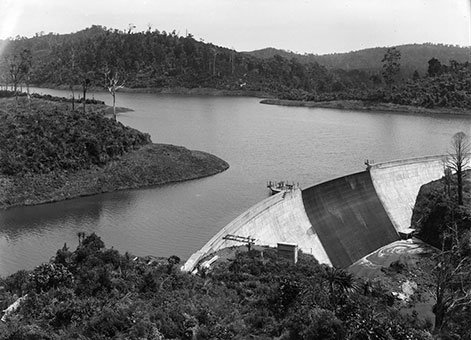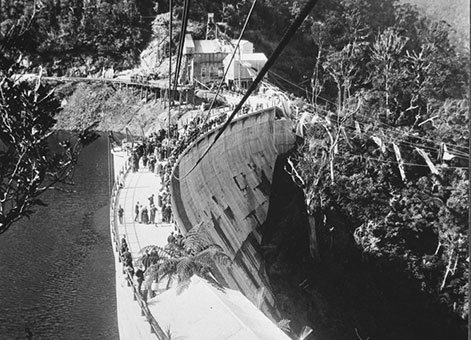The Waitakere Ranges Water Supply System taps into the resources of these ranges in West Auckland and its Huia, Nihotupu and Waitakere streams. A series of five large dams were constructed throughout the 20th century. These created the reservoirs, and associated tramways, piping, tunnels, filter stations, and other structures were also built in order to facilitate access to the water catchment and create a gravitational water supply into Auckland.

Waitakere Dam and Reservoir, 4 November 1917. Sir George Grey Special Collections, Auckland Libraries, 1-W1612.
A good water supply is essential to human existence. Early historical accounts show a marked improvement in health after a piped water supply was introduced to Auckland City from Western Springs in 1877. Financial stringency delayed the water from the Waitakere ranges being supplied to Auckland until 1902 when the first temporary supply was introduced. Severe water shortages and deterioration of the quality of Western Springs water forced Auckland City Council to act. From that time, progressive development of the water resources of the Waitakere Ranges continued to keep up with population growth, not only of Auckland, but also with demands from surrounding districts.
Auckland is very fortunate to have two upland catchment areas, the Waitakere Ranges and the Hunua Ranges, where rainfall is higher than at lower levels and much of the water could gravitate to the City without pumping. The Waitakere water supply followed by supplies from the Hunua Ranges and more recently from the Waikato River has undoubtedly contributed enormously to the wealth and prosperity of the Auckland region.

Official opening of the Nihotupu Dam,1923, Sir George Grey Special Collections, Auckland Libraries, 4-5891.
The system’s main structures are the dams which are still in use:
Waitakere Dam (completed 1910)
Upper Nihotupu Dam (completed 1923)
Upper Huia Dam (completed 1929)
Lower Nihotupu Dam (completed 1948)
Lower Huia Dam (completed 1971)
Concrete gravity dams characterise the first three, while the latter are earth dams. The Waitakere Dam was among the first large scale concrete dams in New Zealand, and the Lower Nihotupu Dam was the country’s first earth dam.
The Waitakere Ranges Water Supply System is of outstanding engineering significance because the succession of structures demonstrates the evolving theory, techniques and materials of New Zealand dams in the twentieth century.
The system is also important because it is associated with many of Auckland’s notable engineers, including:
Hugh Munro Wilson (1865–1929)
James Carlaw
Walter Ernest Bush (1875–1950)
Cyril Firth (1903–2003)
Heritage recognition
The Waitakere Ranges Water Supply System was added to the IPENZ Engineering Heritage Register on 16 October 2011.
Read the heritage assessment. | 1.5 MB
IPENZ “Engineering to 1990” project
The Lower Nihotapu Dam was recognised as part of New Zealand’s engineering heritage during IPENZ's “Engineering to 1990” project which the Institution organised to help celebrate the country’s sesquicentenary in 1990. A plaque was unveiled to mark the significance of this water supply dam as part of the development of the nation.
More information
Access
All of the Waitakere Ranges water supply dams and reservoirs are within the Waitakere Regional Park. Visit the Auckland City Council website for information about visiting the regional park.
Location
Waitakere Ranges, Auckland.
